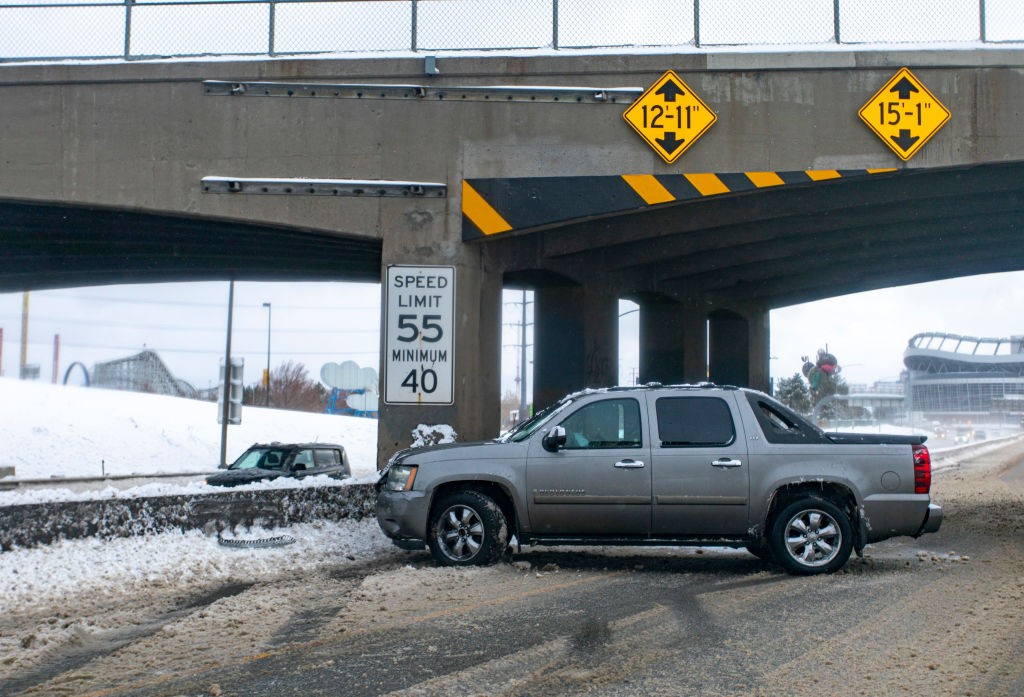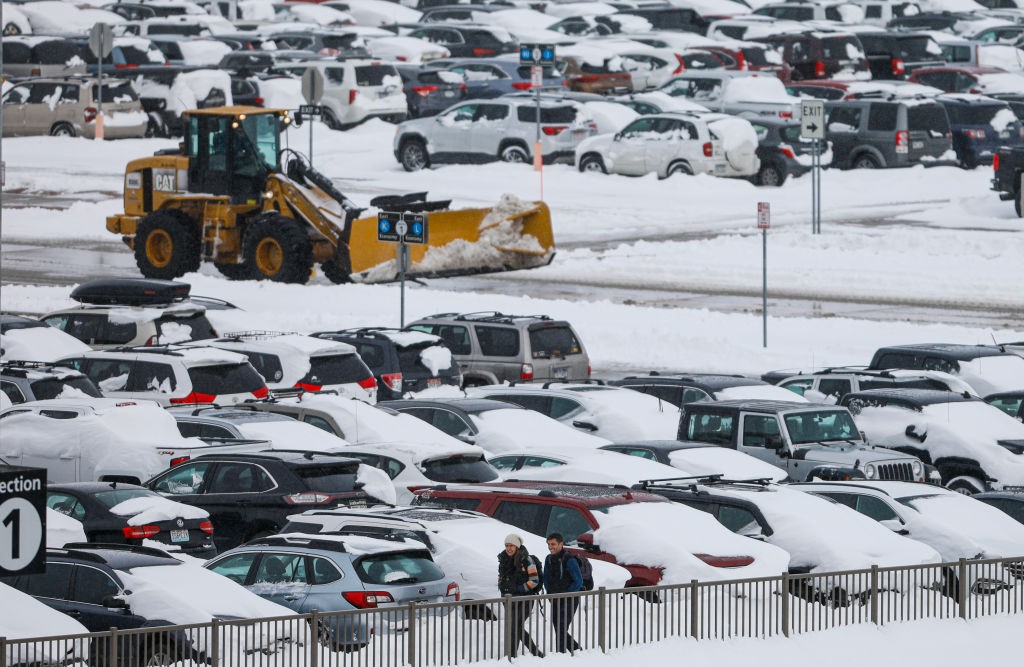MINNEAPOLIS (AP) — A storm packing heavy snow and high winds that wreaked havoc as it whipped through Colorado, Wyoming and Nebraska marched into the upper Midwest on Wednesday as anxious Thanksgiving travelers buckled up and barreled headlong into a busy, if not perilous, holiday week.
The wintry storm that left at least one person dead was expected to push eastward into South Dakota, Iowa, Michigan, Minnesota and Wisconsin, while a “bomb cyclone” weather phenomenon was expected to simultaneously topple trees, knock out power and dump snow as it rolled into California and Oregon.
The one-two punch made for a double whammy of early wintry weather that threatened to scramble plans for millions of people nationwide during one of the busiest travel weeks of the year.

A truck rest across two lanes of Interstate 25 after spinning out on icy, snowy roads on November 26, 2019 in Denver, Colorado. Nearly a foot of snow fell leading several metro districts to enact accident alerts. (Joe Mahoney/Getty Images)
Minnesotans prepared Wednesday for a winter-like blast that’s expected to deliver heavy snow and powerful winds. The University of Minnesota Twin Cities campus canceled classes starting late Tuesday and was not expected to resume operations until Thursday. National Weather Service meteorologist Brent Hewett in Chanhassen, Minnesota, said the storm could dump 6 inches (15 centimeters) of snow in central and southern Minnesota, while some areas could see 9 to12 inches (22.9 to 30.5 centimeters).
Western and northern Wisconsin could be buried beneath 8 to 12 inches (20 to 30.5 centimeters) of snow, with 12 to 15 inches (30.5 to 38 centimeters) of lake-effect snow near Lake Superior. A raw, blustery day is forecast Wednesday, with winds up to 35 mph (56 kph). Forecasters said another storm could arrive this weekend, just as people are returning from Thanksgiving.
“It’s one of those things, you couldn’t make it up if you tried,” Hewett said of back-to-back storms falling around the holiday.
On Tuesday, weather-related damage was widespread nationwide. Authorities on both sides of the California-Oregon border reported numerous crashes and closed roads. The National Weather Service urged people to wait to travel for the holiday until the weather improved.
At Denver International Airport, about 10 inches (25 centimeters) of snow mixed with winds that limited visibility prompted the cancellation of about 30% of the airport’s average daily 1,600 flights.

People walk past snow-covered cars parked as a plow clears roadways at Denver International Airport on November 26, 2019 in Denver, Colorado. Flights were delayed and rescheduled due to a winter storm that dropped nearly a foot of snow in the city. (Joe Mahoney/Getty Images)
The storm dumped nearly 3 feet (1 meter) of snow in parts of northern Colorado and closed long stretches of highways there and in Wyoming. One person was killed, and two others were injured when a tractor-trailer jackknifed and was hit by two other trucks on Interstate 70 near the Colorado ski town of Vail.
The system eventually moved east, allowing the Denver airport to begin returning to normal.
Southwest Airlines canceled about 200 flights. Spokesman Brad Hawkins said it would take “a couple of days” to get stranded passengers on other flights because there are few during the pre-Thanksgiving travel crush. That makes it hard for airlines to rebook passengers.
About 1,100 people spent the night at the airport, including many cadets from the Air Force Academy near Colorado Springs who either missed flights or wanted to get to the airport before road conditions deteriorated, airport spokeswoman Alex Renteria said.
Among them was cadet Sadie Luhman, whose trip to the airport took three hours — twice the normal driving time. She got to the airport at 1 a.m., 10 hours before her scheduled flight to Chicago for Thanksgiving.
“I just wanted to beat the storm. We kind of left in the middle of it so it kind of didn’t work, but we got here,” she told Denver news station KCNC-TV.
Airport workers handed out blankets, diapers, baby formula, toothbrushes and toothpaste to passengers who camped out on floors and in chairs.
Many government offices closed in the Denver area and Cheyenne, Wyoming, along with colleges and schools not already on holiday break. In Nebraska, several school districts canceled classes Wednesday, and the southwestern city of Sidney had received about 8 inches (20 centimeters) of snow.
But Tuesday wasn’t a snow day for everyone. Carli Webber cleared snow off her car and braced herself for her commute to a call center near Denver’s Union Station.
“I am not like a lot of people and cannot work from home, so I have no choice but to go,” she said.
Blizzard and wintry weather warnings extended into the Great Lakes states with the storm bringing high winds and snow to Michigan, Minnesota and Wisconsin and a chance of snow over the weekend for parts of New England, said Alex Lamers, a National Weather Service meteorologist.
“That could be a coast-to-coast storm,” he said.
The storm was expected to dump snow on the airport in Minneapolis, where Delta Air Lines is the major carrier, but most was expected to fall overnight when few flights were scheduled.
Delta prepared by filling de-icing tanks, calling in extra flight dispatchers and operations employees, and having some of its 20 in-house meteorologists focus on the Minneapolis forecast.
“The timing is very helpful,” said Erik Snell, a Delta senior vice president who oversees operations. “It gives the airport time to clear the runways, although we’ll have to watch the residual snowfall in the morning.”
The storm system could mean disappointment for fans of the larger-than-life balloons flown at Macy’s Thanksgiving Day Parade in New York.
Organizers were preparing for the possibility of grounding the iconic balloon characters because of 40-50 mph (64-81 kph) gusts in the forecast. Rules put in place after several people were injured by a balloon years ago require lower altitudes or full removal if sustained winds exceed 23 mph (37 kph) and gusts exceed 34 mph (54 kph). The decision will be made on parade day.
The second storm began hitting the West Coast of the U.S., bringing snow to the mountains and wind and rain along the coasts of California and Oregon.
Multiple roads were closed in southern Oregon due to downed trees and power lines and blizzard-like driving conditions and others were reduced to a single lane, the Oregon Department of Transportation said.
The bomb cyclone — a rapid drop in air pressure — could bring waves of up to 35 feet (11 meters), wind gusts of up to 75 mph (120 kph) and heavy snow in the mountains.
Snow temporarily shut down part of Interstate 80 north of Lake Tahoe, near the Nevada-California line.
Angela Smith said the Oceanfront Lodge, a hotel she manages in Crescent City, in far Northern California, lost power briefly during rain and strong winds. She said the hotel is ready to withstand heavy downpours.
“It’s blowing pretty good outside but because we’re right on the coast, everything was built to ensure the safety of people,” Smith said.
Forecasters warned of “difficult to impossible travel conditions” across much of northern Arizona later this week as that storm dumps about 2 feet (61 centimeters) of snow. The approaching storm accelerated the annual winter closure of the highway leading to the North Rim of the Grand Canyon by five days.

COMMENTS
Please let us know if you're having issues with commenting.